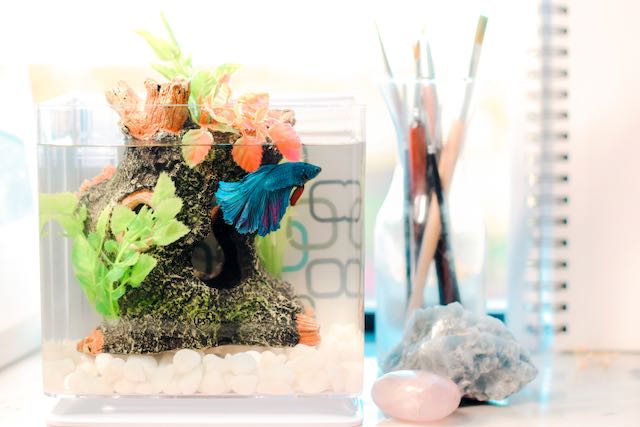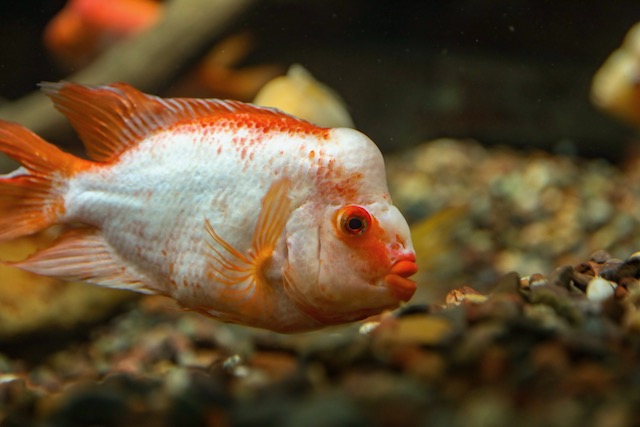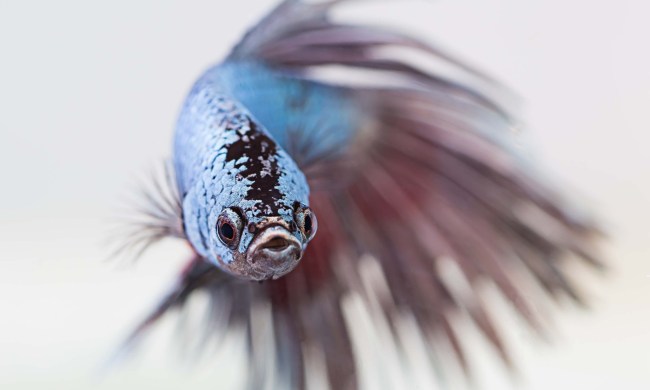Whether you’re interested in breeding or just want to choose an appropriate name, knowing how to tell the sex of your fish can prove highly useful. The determining features that identify fish as male or female are different for each breed. However, there are some common ways that fish parents can determine the sex of their fish.

General tips and tricks
Most gender characteristics will not show themselves until the fish have reached their sexual maturity. This age is different for many breeds, but it is safe to say that around 2–3 months old, most fish species are sexually mature. Meaning any colorations, unique gender growths, or spawning signs will be more apparent and more easily noticed.
Colors
As with many birds, male fish tend to be more colorful. This color difference between males and females can exist for multiple reasons. Males are more colorful to attract a mate or to distract predators from their eggs. Male betta fish even chase the females away from the eggs.
Head bulges
Many male fish like tilapia or oscars will grow a distinctive bump on their forehead. Located between the eyes and above the mouth, this bump can make it easy to identify a male fish.
Growths and designs
During the spawning season, some male fish will develop impressive growths or designs. These identifying characteristics will appear anywhere on the body, including the head. For example, male pleco fish will grow long whiskers on the edge of their mouth and pectoral fins.
Spawning season differences
Spawning season is usually the best time to identify the sex of your fish. During this time, females will appear larger and rounder than their male counterparts. The surest way to know the sex of your fish is to wait and see who lays the eggs. However, if breeding isn’t a part of your fish-raising plans, you might want another option.
Aggressive behavior
As fish attain sexual maturity, many male fish will become aggressive toward other fish in the tank. These hostile manners can be observed when other fish approach them or swim into what the aggressive fish has decided is his territory. The territorial fish will charge the intruder. If you see this behavior in your tank, you most likely have a male.
Specific species identifiers
Although the tips above can help with many breeds, some fish have a unique way of showing gender. Of course, many fish are not discussed here, but many common or popular fish species will be. For more rare and exotic species, be sure to contact an expert for advice.
Goldfish
In season, male goldfish will develop bumps around their gills, foreheads, and pectoral fins. However, these bumps are there only during the breeding season. Once spring has ended, you’re not likely to find these bumps.
Betta fish
The picture of a betta fish is typically a beautifully colored fish with large, flowing fins. That is a male betta. Possibly one of the easiest fish species for identifying the sex, bettas are brightly colored when male and usually dull brown with smaller fins when female.
Guppies and mollies
For guppies and mollies, it’s easiest to look for the anal fin. Toward the back of the fish, near the tail, there will be a triangular fin called an anal fin. This three-sided appendage is present only on males and is used for reproductive purposes. Keep in mind that it might be harder to see on a smaller fish.
Pleco fish
As mentioned above, male plecos will grow long whiskers that are hard to miss. Females also grow these adorable whiskers, but they are significantly smaller and shorter than the males’. If it’s hard to determine whose whiskers are longer, watch for aggressive behavior. Male pleco fish often charge other fish that get close.
Cichlid fish
Some common cichlid fish are tilapia, angelfish, oscars, and discus. These can be some of the most challenging fish for identifying sex. Waiting until they are of mature age will help immensely. When a male cichlid is mature, its dorsal fin is noticeably larger and longer than the females’.
Gourami
As with cichlids, identifying the sex of gourami fish is difficult. But you may be able to identify the sex by looking at the dorsal fin. In males, the dorsal fin is long and tapers to a point. Females have a shorter and more rounded dorsal fin.
Tetras
Tetras have a mixture of previously talked-about signs. As with many fish, female tetras are usually longer and fuller in shape, and males are more colorful and have longer fins.
Koi
Another hard-to-sex fish is the koi. Even many experts make mistakes in sexing koi, and most shops and aquariums will use ultrasound to verify the sex of their koi. You can look for size differences. Females, once again, will be larger and rounder, while males will be skinnier.
Fish are some of the hardest pets for identifying their sex. However, with these tips and tricks, you’ll be able to try your hand at figuring out the sex of your fish.
Want more? Read on further to learn how to breed and raise minnows. Or if you want something else, learn how to train your betta fish with our top tips.



